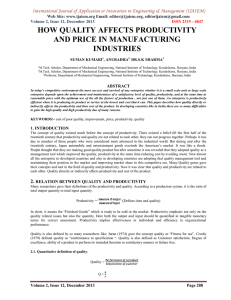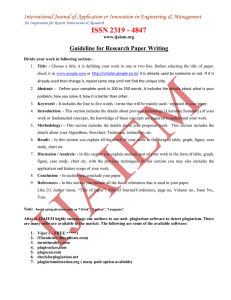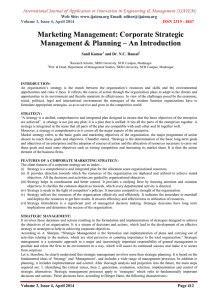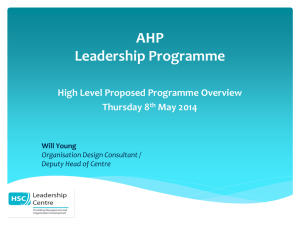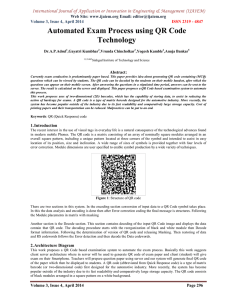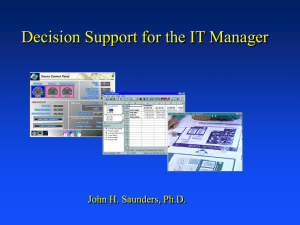Evaluation of factor affecting the Quality of Teaching in Technical Institute
advertisement
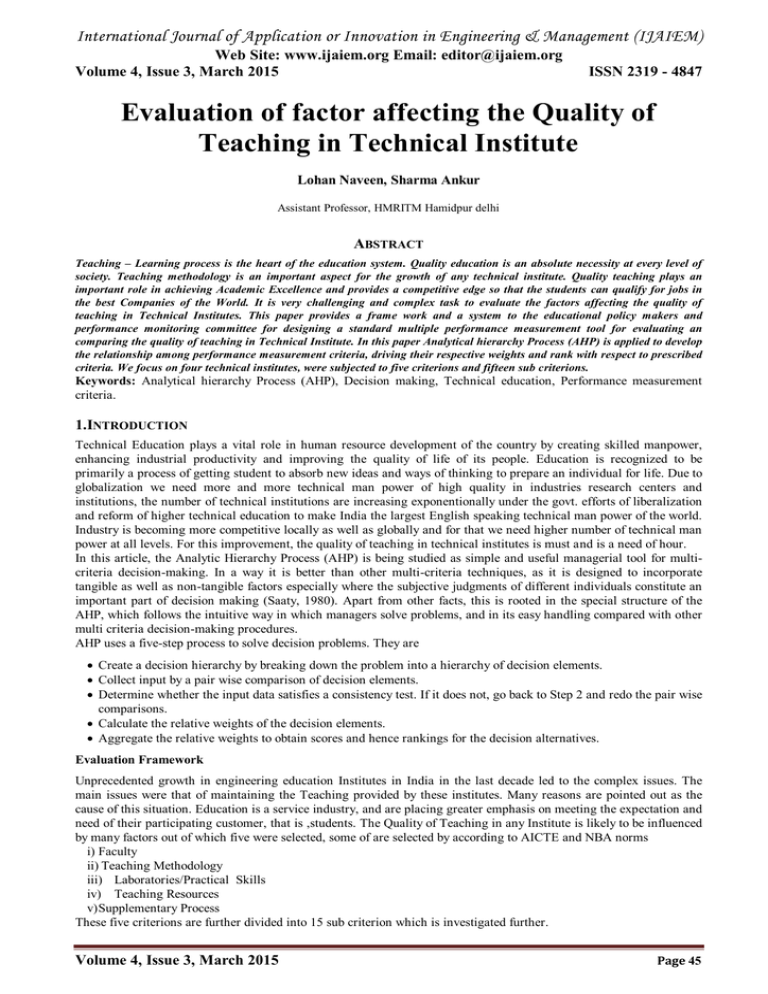
International Journal of Application or Innovation in Engineering & Management (IJAIEM) Web Site: www.ijaiem.org Email: editor@ijaiem.org Volume 4, Issue 3, March 2015 ISSN 2319 - 4847 Evaluation of factor affecting the Quality of Teaching in Technical Institute Lohan Naveen, Sharma Ankur Assistant Professor, HMRITM Hamidpur delhi ABSTRACT Teaching – Learning process is the heart of the education system. Quality education is an absolute necessity at every level of society. Teaching methodology is an important aspect for the growth of any technical institute. Quality teaching plays an important role in achieving Academic Excellence and provides a competitive edge so that the students can qualify for jobs in the best Companies of the World. It is very challenging and complex task to evaluate the factors affecting the quality of teaching in Technical Institutes. This paper provides a frame work and a system to the educational policy makers and performance monitoring committee for designing a standard multiple performance measurement tool for evaluating an comparing the quality of teaching in Technical Institute. In this paper Analytical hierarchy Process (AHP) is applied to develop the relationship among performance measurement criteria, driving their respective weights and rank with respect to prescribed criteria. We focus on four technical institutes, were subjected to five criterions and fifteen sub criterions. Keywords: Analytical hierarchy Process (AHP), Decision making, Technical education, Performance measurement criteria. 1.INTRODUCTION Technical Education plays a vital role in human resource development of the country by creating skilled manpower, enhancing industrial productivity and improving the quality of life of its people. Education is recognized to be primarily a process of getting student to absorb new ideas and ways of thinking to prepare an individual for life. Due to globalization we need more and more technical man power of high quality in industries research centers and institutions, the number of technical institutions are increasing exponentionally under the govt. efforts of liberalization and reform of higher technical education to make India the largest English speaking technical man power of the world. Industry is becoming more competitive locally as well as globally and for that we need higher number of technical man power at all levels. For this improvement, the quality of teaching in technical institutes is must and is a need of hour. In this article, the Analytic Hierarchy Process (AHP) is being studied as simple and useful managerial tool for multicriteria decision-making. In a way it is better than other multi-criteria techniques, as it is designed to incorporate tangible as well as non-tangible factors especially where the subjective judgments of different individuals constitute an important part of decision making (Saaty, 1980). Apart from other facts, this is rooted in the special structure of the AHP, which follows the intuitive way in which managers solve problems, and in its easy handling compared with other multi criteria decision-making procedures. AHP uses a five-step process to solve decision problems. They are Create a decision hierarchy by breaking down the problem into a hierarchy of decision elements. Collect input by a pair wise comparison of decision elements. Determine whether the input data satisfies a consistency test. If it does not, go back to Step 2 and redo the pair wise comparisons. Calculate the relative weights of the decision elements. Aggregate the relative weights to obtain scores and hence rankings for the decision alternatives. Evaluation Framework Unprecedented growth in engineering education Institutes in India in the last decade led to the complex issues. The main issues were that of maintaining the Teaching provided by these institutes. Many reasons are pointed out as the cause of this situation. Education is a service industry, and are placing greater emphasis on meeting the expectation and need of their participating customer, that is ,students. The Quality of Teaching in any Institute is likely to be influenced by many factors out of which five were selected, some of are selected by according to AICTE and NBA norms i) Faculty ii) Teaching Methodology iii) Laboratories/Practical Skills iv) Teaching Resources v) Supplementary Process These five criterions are further divided into 15 sub criterion which is investigated further. Volume 4, Issue 3, March 2015 Page 45 International Journal of Application or Innovation in Engineering & Management (IJAIEM) Web Site: www.ijaiem.org Email: editor@ijaiem.org Volume 4, Issue 3, March 2015 ISSN 2319 - 4847 Faculty The most important component that goes into making a good institution is a good faculty, its qualifications. How many are Ph.ds. How many are having M.tech. The better the faculty better should be the research output. Doing research keeps a teacher up-to-date on the area, and makes his/her understanding of the subject better. This can help the quality of teaching. And Its knowledge benefits to the students. Experience and well qualified faculty play an important role in development of students and research activities which lead to the development of Technical Institutes. Teaching Methodology It includes: i).Interactive method of teaching (IMT)/ presentation method of teaching (PMT) through Questions and answers, Discussions, Exchange of thoughts. Teaching through- telling, explaining, describing, numerating, narrating, showing, demonstrating, dramatizing ii) Guided Project & Case Study: Introducing Practical Design Experience and Real Life Scenarios into the classrooms iii) Co-operative Learning/ Tutorial: It is instruction that involves students working in teams to accomplish an assigned task and produce a final product (e.g., a problem solution, critical analysis, laboratory report, product design) Laboratories/ Practical skills An important challenge of technical education is to integrate the acquisition of domain specific knowledge and skills and further to encourage student top apply their knowledge to solve problem and to tackle problems at higher levels So the qualification and skills of supporting staff help the students to improve the practical knowledge. Engineering student must have a knowledge of nature that goes beyond mere theory knowledge that is traditionally gained in educational laboratories so Good institute must have well equipped laboratories with modern facilities and also to update/maintain equipment in laboratories. Teaching Resources An Institution must have Library, Digital library, Journals, well equipped laboratories and workshop, availabilities of teaching aids like LCD projector, OHP, seminar halls conference room and last but not least advance computing Facilities. These facilities are initial prerequisite for any technical institution which must be present to ensure proper functioning of Technical Institution. Journal gives you a space to generate teaching ideas, work out pedagogical problems, reflect on your successes and struggles in the classroom, and put your past insights to work in planning future courses. Consequently, Students rarely get a chance to generate their own meanings as they read and compose from their own thoughts as they write. Reading journals help the students to discover their own paper topics in the connections that keep appearing in the right-hand section of these notebooks. Supplementary Process Seminars offer you an interactive environment where you can learn from experts, practice with peers, and receive employer tips. Seminars and workshops provide real learning value for students. The seminar helps you start building your career plan. Because there is such a wide range of possible jobs, companies and industries to work in, this seminar helps you search for your own career path. Industry visits sensitize students to the practical challenges that organizations face in the business world. Industrial visits also give greater clarity about various management concepts for students as they can practically see how these concepts are put into action as well as useful information related to the practical aspects of the educational course which cannot be visualized in lectures. Research and Development (R&D) is a key element of any organizations. R & D helps building product indigenously and progressively grows to build an ecosystem and institutional framework for innovation, technology development, skills, delivery plans, and market orientation in a number of niche areas of national importance and market relevance. The other importance of R&D is to generate quality manpower and develop skilled professionals Analytic Hierarchy Process AHP is a mathematical technique used for multi-criteria decision-making. In a way it is better than other multi-criteria techniques, as it is designed to incorporate tangible as well as non-tangible factors especially where the subjective judgments of different individuals constitute an important part of decision making (Saaty, 1980). Apart from other facts, this is rooted in the special structure of the AHP, which follows the intuitive way in which managers solve problems, and in its easy handling compared with other multi criteria decision-making procedures. Hence the intuitively solved decision problems can now be solved as procedure-orientated using AHP. The use of AHP leads to both, more transparency of the quality of management decisions and an increase in the importance of AHP (Ossadnik W& Lange O, 1999). The stages of AHP are described below: A.Structuring the decision hierarchy Firstly, the decision points are determined. Then, the factors influencing a decision are described. The number of decision points is shown with “m” and the factors affecting the decision points are presented with “n”. Volume 4, Issue 3, March 2015 Page 46 International Journal of Application or Innovation in Engineering & Management (IJAIEM) Web Site: www.ijaiem.org Email: editor@ijaiem.org Volume 4, Issue 3, March 2015 ISSN 2319 - 4847 B. Establishing a comparison matrix of the factors The comparison matrix is a square matrix with n x m dimensions. The evaluation factors make up the rows and columns of the matrix. Using the relative importance scale, as shown in Table 1, makes the comparisons. Since the values on the diagonal represent the same factor, they become 1. If the preference is used in favour of the factor in the row when the factor in any row is compared with the factor in the column, fraction (1/importance value) is preferred [11] Table: Scale of relative importance C. Determining percentages for the importance distribution of the factors The B row vector with n × 1 dimensions is established by using row vectors building the comparison matrix for importance distribution. Bi = .bij. n × 1 …, i = 1, 2,…, n …, Formula 1 The components of this vector are calculated by using Formula 2, with the utilization of the elements of the comparison matrix (aij). In other words, the elements of the B row vector are calculated by dividing the elements in the lines of the comparison matrix with the row sums [7,8]. Then, the obtained n times B row vector is structured in a matrix format and the median values of the elements in every row are calculated. The n value obtained in this way gives the percentage distribution of value factors, that is, importance values (W priority vector with n × 1 dimensions). Bij = ______.........................Formula 2 D. Finding the percentage importance distribution in m decision points for every factor In this stage, the percentage of importance distribution related to every factor is determined as explained in b and c. In other words, pair-wise comparisons and matrix operations as explained in c are repeated as many times as the number of factors. However, in this time the dimensions of comparison matrices to be used in decision points for every factor will become m × m. After every comparison operation, S column vectors with m × 1 dimensions and showing percentage distribution of every evaluated factor to the decision points are obtained [9]. E. Reaching the result distribution in the decision points. In this stage, n times S column vectors are all brought together. Thus, a matrix with m × n dimensions is obtained. When this matrix is multiplied with the W priority vector the percentage distribution of decision points (alternatives) is reached. Volume 4, Issue 3, March 2015 Page 47 International Journal of Application or Innovation in Engineering & Management (IJAIEM) Web Site: www.ijaiem.org Email: editor@ijaiem.org Volume 4, Issue 3, March 2015 ISSN 2319 - 4847 Research Methodology and Results Quality of Teaching is the basic requirement of any Technical Institute. The Quality of Teaching depends upon several attributes such as faculty, Teaching methods, laboratories and extra facilities. However relative priority of these factors may vary depending on variation of individual viewpoint. In this paper an attempt has been made to rank these attributes through a strategic mathematical tool based on data bank containing a number of expert opinion. In this study AHP method has been used to determine the significant factor influencing overall Quality index of Teaching of an Institute hat would be helpful in comparing various institute and select the best one having Quality Teaching. The main purpose of the study is to present consistency and feasibility of AHP in decision process. For this reason some of figure related to Evaluation criteria are fictitious. The logic integrity of model is however considered. As AHP has no effect on how criterions are chosen or how hierarchy is created that is the job of decision maker or decision analyst. So the decision team has been formed which consist of authors of paper 05 pass out students, 05 Assistant professor and 02 Director of different Institutes. Our study investigates 15 Evaluation Criterion under the 05 main sections and then makes a semi fictitious chart. In this firstly, available data are collected from websites of different considered Institute and unavailable data are making fictitious with the help of Faculty and student of considered Institute. Then with the help of decision team marked Evaluation criterions out of 10 as shown in Table 2.Now the role of AHP arises the decision team firstly structured the decision hierarchy and compared the decision criteria with each other using Table 1. In the comparisons, every factor was compared with the others independently. If the predominance was used in favor of the base factor, the integer was given. If the predominance was employed in favor of the compared factors, the fraction was given. Volume 4, Issue 3, March 2015 Page 48 International Journal of Application or Innovation in Engineering & Management (IJAIEM) Web Site: www.ijaiem.org Email: editor@ijaiem.org Volume 4, Issue 3, March 2015 ISSN 2319 - 4847 Table 3: Expert’s opinions on alternative with respect to different criteria Volume 4, Issue 3, March 2015 Page 49 International Journal of Application or Innovation in Engineering & Management (IJAIEM) Web Site: www.ijaiem.org Email: editor@ijaiem.org Volume 4, Issue 3, March 2015 CI: 0,5374 CR: 0,3402 ISSN 2319 - 4847 λ: 22,5243 The first step would be to define a set in which we list the elements of the selection – the set of alternatives from which we wish to choose the best one for ourselves. Then we define the criteria we will use to compare those alternatives. It is clear that you, as the decision maker, determine all of this. That fact alone guarantees that the decision will be based on your preferences. For the explanation of the following steps we will use mathematical language. If n is the number of criteria or alternatives whose weight (priority, importance) wi should be defined based on the assessment of the values of their ratios aij = wi/wj. If we form a matrix A from the ratio of their elevant importance aij, in case of consistent assessments equaling to aij= aik*akj, it will correspond to the equation Aw=nw Matrix A has special characteristics (all her rows are proportional to the first row, all are positive and aij=1/aji is accurate resulting in only one of its eigen values being different from 0 and equal to n. If A matrix has inconsistent changes (in praxis that is always the case) the importance vector w can be calculated by solving the equation (A- λI)w=0 The condition: SUM Awi=1 is true, where λmax is the biggest eigenvalue of A matrix. Due to the characteristics of the matrix λmax ≥ n, and the subtraction λmax – n is used in the measuring of the assessment consistency. With a consistency index CI = (λmax –n)/(n-1) we calculate the consistency ratio CR=CI/RI where RI is a random index (consistency index for the n row matrixes of randomly generated comparisons in pairs – a table with calculated values applies Value of the random index RI If CR≤ 0,1000 is true for matrix A the assessments of the relative importance of the criteria ( alternative priorities) are considered as acceptable. To the contrary, the reasons why the assessment inconsistency is acceptably high must be investigated. It will often happen that the consistency ratio exceeds 0,1000. That should only be taken into account as an indicator of the inconsistency level of your selection. Despite the inconsistency, you will get a suggestion of the best alternative. Volume 4, Issue 3, March 2015 Page 50 International Journal of Application or Innovation in Engineering & Management (IJAIEM) Web Site: www.ijaiem.org Email: editor@ijaiem.org Volume 4, Issue 3, March 2015 ISSN 2319 - 4847 That is the value of this method. You can always revise the chosen importance intensities and check which alternative is the best and to what extent compared to the following one. CI: 0,0386 CR: 0,0433 λ: 4,1157 CI: 0,0146 CR: 0,0164 λ: 4,0437 CI: 0,0146 CR: 0,0164 λ: 4,0437 CI: 0,0246 CR: 0,0276 λ: 4,0738 CI: 0,0146 CR: 0,0164 λ: 4,0437 Volume 4, Issue 3, March 2015 Page 51 International Journal of Application or Innovation in Engineering & Management (IJAIEM) Web Site: www.ijaiem.org Email: editor@ijaiem.org Volume 4, Issue 3, March 2015 CI: 0,0243 CR: 0,0273 λ: 4,0729 CI: 0,0148 CR: 0,0166 λ: 4,0443 CI: 0,0146 CR: 0,0164 λ: 4,0437 CI: 0,0245 CR: 0,0276 λ: 4,0736 CI: 0,0144 CR: 0,0162 λ: 4,0432 CI: 0,0440 CR: 0,0495 λ: 4,1321 Volume 4, Issue 3, March 2015 ISSN 2319 - 4847 Page 52 International Journal of Application or Innovation in Engineering & Management (IJAIEM) Web Site: www.ijaiem.org Email: editor@ijaiem.org Volume 4, Issue 3, March 2015 CI: 0,0245 CR: 0,0275 λ: 4,0735 CI: 0,0245 CR: 0,0275 λ: 4,0735 CI: 0,0144 CR: 0,0162 λ: 4,0432 CI: 0,0146 CR: 0,0164 λ: 4,0437 ISSN 2319 - 4847 Table : Results Volume 4, Issue 3, March 2015 Page 53 International Journal of Application or Innovation in Engineering & Management (IJAIEM) Web Site: www.ijaiem.org Email: editor@ijaiem.org Volume 4, Issue 3, March 2015 ISSN 2319 - 4847 consistency ratio (CR): 0,2265 CONCLUSION The Research effort of this paper is to integrate AHP and factors affecting quality of teaching into the institute driven course design process. In this paper we have briefly examined the various factors which affect the quality of teaching in technical education and have categorized them into fifteen sub criteria. A mathematical model has been evolved for the assessing the effectiveness in terms of these factors. The proposed model can be used to quantify the effectiveness of a technical institution with very good accuracy. A pair wise comparison method was used to calculate the importance for each criterion based on semi factious data gather from four technical institutes. Now the experimental results show that the evaluation for teaching quality based on AHP has excellent results. REFERENCES [1] Saaty, T. L., “Analytic Hierarchy Process”, McGraw Hill, New York, (1980). [2] Saaty, T. L., “Multi-criteria Decision Making: Analytic Hierarchy Process”, RWS Publications, Pittsburgh, (1990). [3] Armacost, R.L., “Identification of Determinant Attributes Using The Analytic Hierarchy Process”, Journal of Academy of Marketing Science, 22: 383 (1994). [4] Namish Mehta “Evaluating performance of technical institute using analytic hierarchy process”, International Journal on Emerging Technologies 1(2): 91-99(2010) [5] Li Qing-jiang “Evaluation for Teaching Quality of University Based on AHP” 2012 International Conference on Convergence Information Technology Lecture Notes in Information Technology, Vol.19 [6] http://www.123ahp.com/Medjurezultat.aspx Volume 4, Issue 3, March 2015 Page 54

